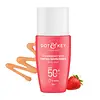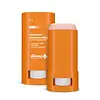Dot & Key Skincare Strawberry Dew Tinted Sunscreen SPF 50+ Versus The Derma Co Hyaluronic Sunscreen Stick SPF 60
What's inside
What's inside
 Key Ingredients
Key Ingredients

 Benefits
Benefits

 Concerns
Concerns

 Ingredients Side-by-side
Ingredients Side-by-side

Water
Skin ConditioningEthylhexyl Methoxycinnamate
UV AbsorberButyl Methoxydibenzoylmethane
UV AbsorberBenzophenone-3
UV AbsorberPhospholipids
Skin ConditioningButylene Glycol
HumectantIsododecane
EmollientGlycerin
HumectantPhenyl Trimethicone
Skin ConditioningPropanediol
SolventTitanium Dioxide
Cosmetic ColorantTriethoxycaprylylsilane
Polyhydroxystearic Acid
EmulsifyingGlyceryl Citrate/Lactate/Linoleate/Oleate
EmulsifyingCyclopentasiloxane
EmollientDimethicone Crosspolymer
Emulsion StabilisingCaprylic/Capric Triglyceride
MaskingDicaprylyl Carbonate
EmollientTapioca Starch
Polymethylsilsesquioxane
Fragaria Vesca Fruit
AstringentFragaria Ananassa Fruit Extract
Skin ConditioningSodium Hyaluronate
HumectantNiacinamide
SmoothingPanthenol
Skin ConditioningTocopheryl Acetate
AntioxidantPolyglyceryl-3 Polyricinoleate
EmulsifyingXanthan Gum
EmulsifyingPolyacrylate Crosspolymer-6
Emulsion StabilisingPolyacrylate-13
Polyisobutene
Polysorbate 20
EmulsifyingSodium Gluconate
Skin ConditioningPhenoxyethanol
PreservativeEthylhexylglycerin
Skin ConditioningDisodium EDTA
CI 77491
Cosmetic ColorantCI 77492
Cosmetic ColorantWater, Ethylhexyl Methoxycinnamate, Butyl Methoxydibenzoylmethane, Benzophenone-3, Phospholipids, Butylene Glycol, Isododecane, Glycerin, Phenyl Trimethicone, Propanediol, Titanium Dioxide, Triethoxycaprylylsilane, Polyhydroxystearic Acid, Glyceryl Citrate/Lactate/Linoleate/Oleate, Cyclopentasiloxane, Dimethicone Crosspolymer, Caprylic/Capric Triglyceride, Dicaprylyl Carbonate, Tapioca Starch, Polymethylsilsesquioxane, Fragaria Vesca Fruit, Fragaria Ananassa Fruit Extract, Sodium Hyaluronate, Niacinamide, Panthenol, Tocopheryl Acetate, Polyglyceryl-3 Polyricinoleate, Xanthan Gum, Polyacrylate Crosspolymer-6, Polyacrylate-13, Polyisobutene, Polysorbate 20, Sodium Gluconate, Phenoxyethanol, Ethylhexylglycerin, Disodium EDTA, CI 77491, CI 77492
Dimethicone
EmollientSilica
AbrasiveHomosalate
Skin ConditioningPolyethylene
AbrasiveIsoeicosane
EmollientDiisostearyl Malate
EmollientOctocrylene
UV AbsorberDiethylhexyl Carbonate
EmollientEthylhexyl Salicylate
UV AbsorberSynthetic Wax
AbrasiveSynthetic Fluorphlogopite
Isononyl Isononanoate
EmollientButyl Methoxydibenzoylmethane
UV AbsorberSimmondsia Chinensis Seed Oil
EmollientDibutyl Adipate
EmollientIsododecane
EmollientHydrogenated Vegetable Oil
EmollientDimethicone Crosspolymer
Emulsion StabilisingEthylene/Propylene Copolymer
AbrasiveBis-Behenyl/Isostearyl/Phytosteryl Dimer Dilinoleyl Dimer Dilinoleate
EmollientSilica Dimethyl Silylate
EmollientEuphorbia Cerifera Wax
Cholesterol
EmollientPhytosphingosine
Skin ConditioningCopernicia Cerifera Wax
Ceramide NP
Skin ConditioningPentaerythrityl Tetra-Di-T-Butyl Hydroxyhydrocinnamate
AntioxidantEthylhexyl Palmitate
EmollientButylene Glycol
HumectantCaprylyl Glycol
EmollientPhenoxyethanol
PreservativeSodium Hyaluronate
HumectantHexylene Glycol
EmulsifyingDimethicone, Silica, Homosalate, Polyethylene, Isoeicosane, Diisostearyl Malate, Octocrylene, Diethylhexyl Carbonate, Ethylhexyl Salicylate, Synthetic Wax, Synthetic Fluorphlogopite, Isononyl Isononanoate, Butyl Methoxydibenzoylmethane, Simmondsia Chinensis Seed Oil, Dibutyl Adipate, Isododecane, Hydrogenated Vegetable Oil, Dimethicone Crosspolymer, Ethylene/Propylene Copolymer, Bis-Behenyl/Isostearyl/Phytosteryl Dimer Dilinoleyl Dimer Dilinoleate, Silica Dimethyl Silylate, Euphorbia Cerifera Wax, Cholesterol, Phytosphingosine, Copernicia Cerifera Wax, Ceramide NP, Pentaerythrityl Tetra-Di-T-Butyl Hydroxyhydrocinnamate, Ethylhexyl Palmitate, Butylene Glycol, Caprylyl Glycol, Phenoxyethanol, Sodium Hyaluronate, Hexylene Glycol
 Reviews
Reviews

Ingredients Explained
These ingredients are found in both products.
Ingredients higher up in an ingredient list are typically present in a larger amount.
Also known as Avobenzone, this ingredient is a chemical sunscreen filter that provides protection in the UV-A range.
Avobenzone is globally approved and is the most commonly used UV-A filter in the world.
Studies have found that avobenzone becomes ineffective when exposed to UV light (it is not photostable; meaning that it breaks down in sunlight). Because of this, formulations that include avobenzone will usually contain stabilizers such as octocrylene.
However, some modern formulations (looking at you, EU!) are able to stabilize avobenzone by coating the molecules.
Avobenzone does not protect against the UV-B range, so it's important to check that the sunscreen you're using contains other UV filters that do!
The highest concentration of avobenzone permitted is 3% in the US, and 5% in the EU.
Learn more about Butyl MethoxydibenzoylmethaneButylene Glycol (or BG) is used within cosmetic products for a few different reasons:
Overall, Butylene Glycol is a safe and well-rounded ingredient that works well with other ingredients.
Though this ingredient works well with most skin types, some people with sensitive skin may experience a reaction such as allergic rashes, closed comedones, or itchiness.
Learn more about Butylene GlycolDimethicone Crosspolymer is a silicone created by modifying dimethicone with hydrocarbon side chains. Due to its large size, it does not penetrate skin. It is considered non-occlusive.
Dimethicone Crosspolymer is used to stabilize and thicken products. It also helps give products a silky feel.
Isododecane is a fragrance, emollient, and solvent.
As an emollient, it helps your skin stay soft and hydrated. Emollients help trap moisture into your skin.
Isododecane's role as a solvent makes it a great texture enhancer. It spreads smoothly on skin and does not leave a sticky feeling behind. Isododecane also helps prevent color transfer in makeup products.
Isododecane is not absorbed into skin.
Learn more about IsododecanePhenoxyethanol is a preservative that has germicide, antimicrobial, and aromatic properties. Studies show that phenoxyethanol can prevent microbial growth. By itself, it has a scent that is similar to that of a rose.
It's often used in formulations along with Caprylyl Glycol to preserve the shelf life of products.
Sodium Hyaluronate is hyaluronic acid's salt form. It is commonly derived from the sodium salt of hyaluronic acid.
Like hyaluronic acid, it is great at holding water and acts as a humectant. This makes it a great skin hydrating ingredient.
Sodium Hyaluronate is naturally occurring in our bodies and is mostly found in eye fluid and joints.
These are some other common types of Hyaluronic Acid:
Learn more about Sodium Hyaluronate